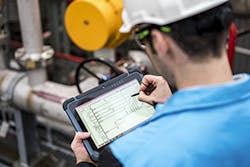[Case history] Machine learning for predictive maintenance
Run-to-failure is increasingly reserved for rare and unique circumstances. This trend started when increasingly capable condition inspection and monitoring tools shifted the asset management focus from “fix what’s broken” to “keep it from breaking down.” Today, unprecedented opportunities afforded by the industrial internet of things (IIoT) have further changed the playing field, and there are potential benefits yet to be realized.
For example, predictive maintenance (PdM), originally based on selected asset condition data, has grown to accommodate online, real-time streams of multiple types of condition data received via sensors and even drones. Some companies are applying machine learning (ML) to further refine their predictive analytics and prognostics.
The newest opportunity, prescriptive maintenance (RxM), is a multivariate approach that merges asset condition data with any combination of operating, environmental, process safety, engineering, supplier, or other related data to better diagnose conditions and prescribe specific options for corrective action. The advanced analytics, pattern recognition, modeling, ML, and artificial intelligence (AI) that empower RxM may help companies finally greatly curtail, if not eliminate, the need for reactive maintenance on critical equipment.
- Read all 7 case histories from our April 2019 cover story, "How 7 companies are accelerating PdM and RxM at their plants."
Covestro was skeptical about the value of machine-learning models, says Jane Arnold, EVP and head of global process control technology, but a study the company did on a large motor failure found that “through ML, we could have detected anomalies starting eight months prior to failure.”
Polymer materials manufacturer Covestro has a vigorous PdM program utilizing traditional condition monitoring rules and algorithms; this is facilitating high overall equipment effectiveness (OEE) for the company’s sites globally.
Covestro will pair this knowledge with ML models for better predictive accuracy, with the goal of further increasing on-stream time and throughput. The company is also starting a pilot for RxM but does not expect to have full results for another year.
“We are still early in utilizing ML for PdM, but we have performed several use cases and are excited about the results,” says Jane Arnold, an executive vice president and the head of global process control technology at Covestro.
One recent use case is a study on a large motor failure. “I was skeptical that the ML engine would be able to detect the failure because there was only data available in one-hour intervals and only whole-number increments on temperatures,” says Arnold. “But, once we completed the study, we found that through ML we could have detected anomalies starting eight months prior to failure.” As a result, Covestro is now identifying all critical equipment that could result in significant production loss due to failure and will check the feasibility to create ML models for them.
In addition, a rollout plan is being formulated. “Our tentative plan is to have a dedicated group in each region that monitors the data models, keeps them healthy, and recommends corrective or preventive maintenance activities when needed to the responsible plant engineers and plant managers based on the data interpretation,” explains Arnold.
Covestro strongly believes that keeping humans as part of the equation is necessary in order to achieve the highest success rate. “Put your best experts on the advanced PdM program using ML,” urges Arnold. “The key is to involve and convince the experts of what is possible. Then, there are no limits to the applications.”


